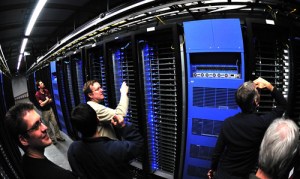Sandy Aftermath: Data Center Real Estate Could Be In Demand
By Karsten Strauss November 16, 2012 5:12 pm
reprints
In the wake of tropical storm Sandy, questions about the vulnerability of Manhattan-based data centers may give rise to an increase in demand for data center space elsewhere in the tri-state area—possibly New Jersey.
Sandy’s impact on New York City data centers – which shut down popular websites Gawker, BuzzFeed and Huffington Post – will likely influence companies that rely on them to seek backup plans to avoid having their databases threatened in the future.
“Typically there tends to be a reaction to an event like this,” said Jeff Hipschman, a managing director and New Jersey office head at CBRE. As a leader in the firm’s Tri-State Technology Practice Group, Mr. Hipschman works directly with users of data centers. He couldn’t say how profound the interest in leasing colocation space will be in the aftermath of the storm or whether CBRE has seen an uptick in users asking for colocation services, but did say, “since the storm, we’ve been very busy.”
From a real estate perspective, owners of facilities that have access to power supplies and can access fiber optic communications networks have the ability to develop their spaces into data centers and stand to gain from companies seeking to colocate, Mr. Hipschman said. New Jersey is an option because of its proximity to New York and its richness in power and fiber optics. Over the past five to eight years there has been a demand for such sites in New Jersey, he said. “A good chunk of that demand comes from financial services.”
These data center sites represent the intersection of real estate and technology and are a growth market, said Mr. Hipschman.
Manhattan poses challenges for maintaining centers, said Thomas Traugott, vice president of data center solutions at Cassidy Turley. Real estate costs are high, generator fuel is expensive and only a certain amount able to be stored on site, buildings have floor loading capacity limits and finding space for generators (and backup generators) can be problematic. Evacuation of a building would require a shutdown because an unmonitored data center could malfunction, causing a fire, Mr. Traugott said.
Following September 11, 2001, Fortune 1000 companies began connecting to new data sites as having a single site located in Manhattan was no longer an option, he said.
One of the more notable data center shutdowns during tropical storm Sandy affected the popular New York gossip site, Gawker. The site is now taking steps to assure that flood and wind never stand in the way of its content again by going through the Amazon EC2 cloud platform, Gawker Media CTO, Thomas Plunkett told The Commercial Observer.
“We have begun the process to identify a second datacenter provider, and location (most likely in New Jersey),” Mr. Plunket wrote in an email. “This second datacenter will be online as soon as possible.”
“Moving to Jersey is not a strategy,” said Lewis Fein, a marketing representative with Colocation America, a Los-Angeles-based colocation host provider. Should a storm of equal or greater intensity hit the tri-state area, companies that sought safety across the river might find their efforts to have been in vain, he said.
“New Jersey was no more immune to the effects of hurricane Sandy than New York,” Mr. Fein said, noting that some areas in New Jersey were harder hit. A better strategy would be to seek collocation providers that have both a national network and 24/7 staff support.
Still, a data center close by offers the highest performance through simple geographical proximity, and whether based in New York or New Jersey, they will continue to operate in the tri-state area, only perhaps now within a greater network of redundancies. “The reality is there are going to be data centers in New York,” Mr. Traugott said.


